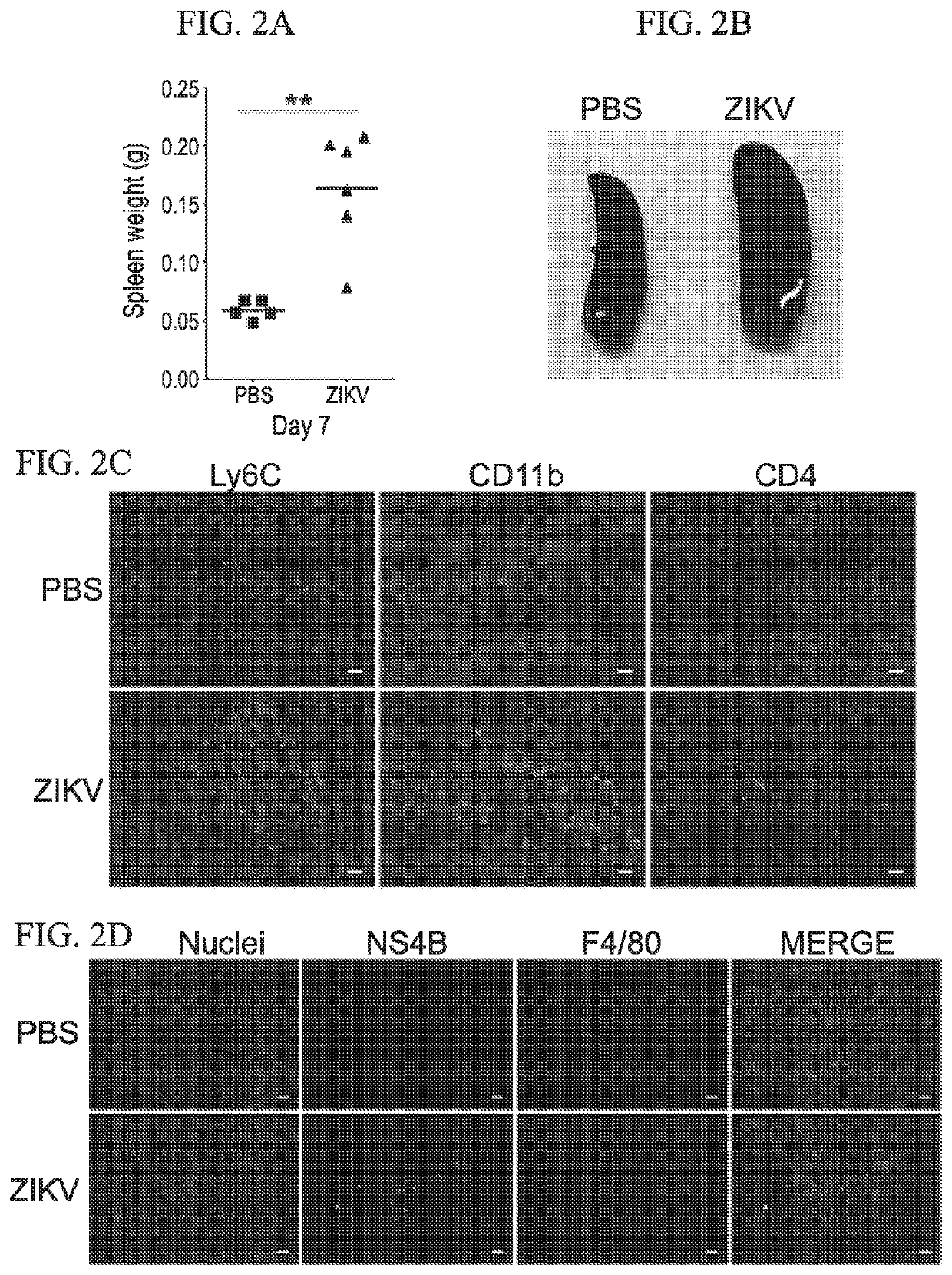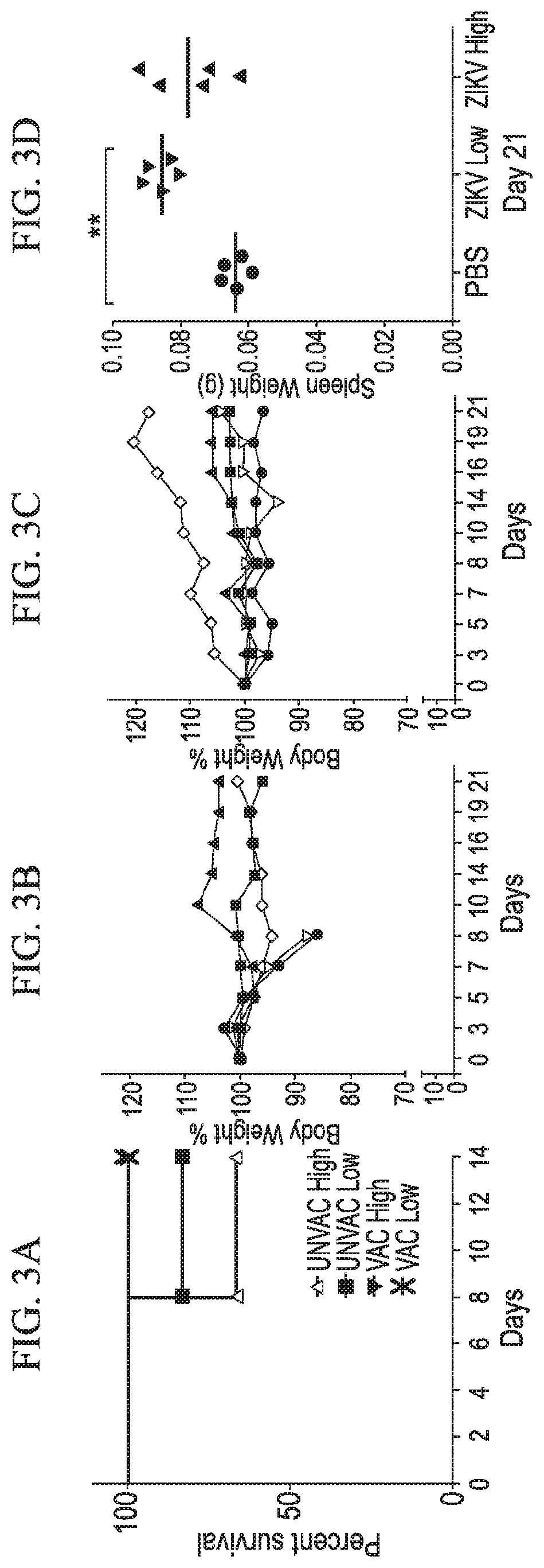Methods to reduce the likelihood of maternal and fetal zika virus disease
- Summary
- Abstract
- Description
- Claims
- Application Information
AI Technical Summary
Benefits of technology
Problems solved by technology
Method used
Image
Examples
example 1
Mouse Model to Investigate ZIKV Disease Pathogenesis
[0073]We utilized ifnar1− / − (A129 or IFN-αβR-KO) mice (MMRRC at Jackson Laboratory) for infection studies. For the initial experiment, mice (n=4 per group) were anesthetized with isoflurane in a desiccator jar within a ductless fume hood. Ear tags were applied for identification purposes. Forty microliters of PRVABC59 ZIKV infectious inoculum (2×106 pfu / mouse) was injected subcutaneously (SC) into each of the right and left hind legs just above the ankle inside a biosafety cabinet. Control mice were inoculated with 40 μL phosphate buffered saline (PBS) in each of the hind legs. For safety reasons, the exposed mice were housed in a dedicated infectious agent isolation cubicle room. The mice were monitored daily for body condition and neurological symptoms. Body weights were measured before euthanasia at the indicated timepoints, as well as for animals requiring euthanasia due to ZIKV-induced disease. By 6-7 dpi, the infected animals...
example 2
[0080]Methods: At day 0, breeding female ifnar1− / − mice was immunized with ZIKV (6.8×105 pfu / mouse) through ocular route (double dose of vaccination group). PBS inoculated mice was included as the unvaccinated group. We used n=6 mice per group. For booster immunization, a second ocular inoculation was performed at day 10 post-immunization. At day 10, ocular immunization was performed for single dose vaccination group as well. At day 31, time mating (timed pregnancy) was set up. At E9.5-E10.5 post-conception (day 42 post-immunization), both vaccinated (single and double dose) and unvaccinated groups were challenged with ZIKV (1×106 pfu / mouse) through SC route. The mice were monitored for the next 7 days for evaluating neurological signs, weight loss, and mortality. At day 49 (E17.5-18.5), mice were humanely euthanized and fetuses were collected and weighed.
[0081]Results: We did not observe any adverse health effect of ocular vaccination in both single and double dose groups. At 31 da...
example 3
Evaluating Rectal Route of Zika Virus Infection in Ifnar1− / − Mice as an Additional Route of Immunization.
[0085]Sexual transmission of ZIKV via vaginal route is well established. Intravaginal inoculation of ZIKV in pregnant ifnar1− / − mice causes intra-uterine growth retardation of fetuses and loss of pregnancy. Development of a prophylactic strategy to induce a mucosal immune response to neutralize Zika viral particles in the vaginal passage is important to prevent congenital infection. Rectal immunization against Rotavirus and Hepatitis A virus has been shown to elicit strong systemic and mucosal immune responses. Rectal infection of ifnar1− / − mice with PRVABC59 did not cause mortality, however, viremia and splenomegaly were present (FIG. 11). While not wishing to be bound by any particular theory, we believe that the mucosal immune response induced by rectal immunization with ZIKV can provide anti-ZIKV protection in the reproductive mucosa. The lymphoid cells present in the rectal ...
PUM
| Property | Measurement | Unit |
|---|---|---|
| Time | aaaaa | aaaaa |
| Time | aaaaa | aaaaa |
| Time | aaaaa | aaaaa |
Abstract
Description
Claims
Application Information
 Login to View More
Login to View More - R&D
- Intellectual Property
- Life Sciences
- Materials
- Tech Scout
- Unparalleled Data Quality
- Higher Quality Content
- 60% Fewer Hallucinations
Browse by: Latest US Patents, China's latest patents, Technical Efficacy Thesaurus, Application Domain, Technology Topic, Popular Technical Reports.
© 2025 PatSnap. All rights reserved.Legal|Privacy policy|Modern Slavery Act Transparency Statement|Sitemap|About US| Contact US: help@patsnap.com



